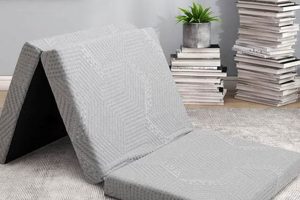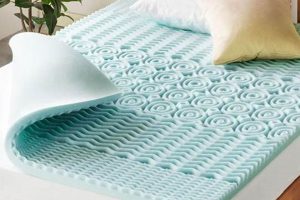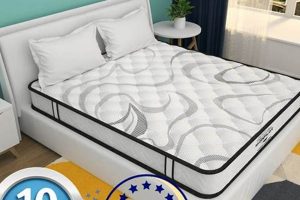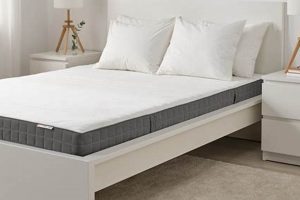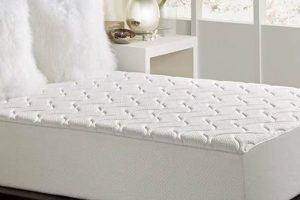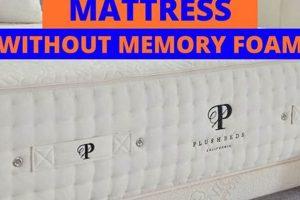A sleep surface incorporating visco-elastic foam, measuring fourteen inches in total thickness, represents a significant investment in sleep quality. The construction typically involves multiple layers, combining a supportive base with progressively softer comfort layers, the uppermost of which is the visco-elastic, or “memory,” foam. This design aims to provide both conforming support and pressure relief, potentially mitigating aches and pains associated with sleeping on less advanced mattresses.
The increased depth of the product allows for a more substantial comfort layer and a more robust support core. This can translate into enhanced durability and a longer lifespan compared to thinner alternatives. Furthermore, the enhanced conformability of a thicker memory foam layer can lead to improved spinal alignment and reduced motion transfer, benefiting individuals who share a bed. Historically, these types of mattresses have gained popularity due to their ability to provide a customized sleep experience, adapting to the individual’s body shape and weight.
The following sections will delve into the specific advantages and disadvantages of mattresses of this depth, examining factors such as material composition, temperature regulation, and long-term value. Understanding these elements is crucial for making an informed decision regarding sleep surfaces and their potential impact on overall well-being.
Selecting a sleep surface is a significant decision. The following tips offer guidance when considering a fourteen-inch memory foam option, focusing on factors impacting long-term satisfaction and value.
Tip 1: Evaluate Density. Higher density memory foam generally correlates with increased durability and support. Inquire about the foam’s density rating (measured in pounds per cubic foot) to gauge its potential lifespan and resistance to sagging.
Tip 2: Consider Layer Construction. Understand the composition of each layer within the mattress. A robust base layer is crucial for providing adequate support and preventing premature wear. Quality transition layers contribute to overall comfort and prevent a sinking feeling.
Tip 3: Assess Temperature Regulation. Memory foam is known to retain heat. Look for features like gel infusions, open-cell structures, or breathable covers designed to mitigate heat buildup and promote airflow.
Tip 4: Check for Certification. Certifications like CertiPUR-US indicate that the foam has been tested for harmful chemicals and meets specific standards for content, emissions, and durability. Prioritize certified products to ensure healthier indoor air quality.
Tip 5: Understand the Firmness Scale. Firmness is subjective, but manufacturers typically use a scale to rate their mattresses. Determine personal preferences and research how the firmness level corresponds to sleeping position and body weight.
Tip 6: Review Warranty Details. A comprehensive warranty protects against manufacturing defects and premature sagging. Carefully examine the warranty terms, including the duration, coverage, and any potential exclusions.
Tip 7: Research Sleep Trials. Many companies offer sleep trials, allowing consumers to test the mattress in their own home for a set period. This is a valuable opportunity to assess comfort and suitability before making a final decision.
By carefully considering density, construction, temperature regulation, certification, firmness, warranty, and sleep trials, a well-informed decision can be made, leading to improved sleep quality and long-term satisfaction.
The subsequent sections will explore specific brands and models within the fourteen-inch category, providing comparative analyses and consumer reviews.
1. Thickness and Support
The relationship between thickness and support in a memory foam mattress is fundamental to its performance and suitability for individual needs. In a fourteen-inch model, the increased thickness inherently allows for a more complex layering system. This typically involves a dense support core, often constructed of high-density polyfoam, which provides the foundational stability. Above this, layers of memory foam of varying densities are incorporated to offer conforming support and pressure relief. The thickness of the comfort layers directly influences the degree to which the mattress conforms to the body’s contours, thereby impacting spinal alignment and reducing pressure points.
A thicker mattress, such as the fourteen-inch variant, can accommodate a wider range of body weights and sleeping positions more effectively than thinner models. For instance, heavier individuals require a thicker and denser support core to prevent excessive sinking and maintain proper spinal alignment. Side sleepers benefit from the deeper comfort layers found in a thicker mattress, as they allow for greater shoulder and hip accommodation, reducing pressure on these areas. Conversely, stomach sleepers may find a fourteen-inch mattress too plush, leading to spinal misalignment unless a firmer support core is present. The interplay between thickness, layer composition, and individual characteristics dictates the overall support and comfort experienced.
In summary, the thickness of a fourteen-inch memory foam mattress enables a sophisticated layering design that can provide enhanced support and pressure relief. However, the specific combination of support core density, comfort layer thickness, and individual sleeping habits must be carefully considered to ensure optimal performance. The thickness alone does not guarantee superior support; rather, it provides the potential for it, contingent upon thoughtful construction and individual suitability.
2. Foam Density
Foam density within a fourteen-inch memory foam mattress is a critical determinant of performance, durability, and overall value. The density of the foam directly impacts its ability to provide support, resist compression, and maintain its structural integrity over time. Understanding the different density levels and their implications is crucial when selecting a mattress.
- Support and Conformity
Higher density foam offers greater resistance to compression, providing enhanced support, particularly for heavier individuals. It also contributes to better spinal alignment and reduces the likelihood of sagging or indentations forming over time. Lower density foam, while initially feeling softer, tends to compress more readily, potentially leading to a loss of support and comfort over the lifespan of the mattress. The fourteen-inch thickness allows for the incorporation of varying densities within different layers, optimizing both support and conformity.
- Durability and Longevity
Density is a primary factor in determining the lifespan of memor
y foam. Higher density foams are more resilient and better able to withstand the constant pressure and weight placed upon them. This translates to a longer-lasting mattress that maintains its shape and support characteristics for an extended period. A fourteen-inch mattress with high-density foam in its support core is likely to outlast a similar mattress with lower-density foam, making it a more cost-effective investment in the long run. - Temperature Regulation
While not the sole factor, foam density can indirectly influence temperature regulation. Denser foams tend to restrict airflow more than less dense foams, potentially leading to increased heat retention. However, manufacturers often employ techniques like open-cell foam structures or gel infusions to mitigate this effect. The effectiveness of these strategies, in conjunction with foam density, determines the overall breathability and temperature neutrality of the mattress. A fourteen-inch mattress may utilize multiple layers to address this, with a high-density support core and a lower-density, more breathable comfort layer.
- Motion Isolation
Higher density foam generally exhibits better motion isolation properties. This means that movements on one side of the mattress are less likely to be transferred to the other side, minimizing disturbance for sleeping partners. The dense structure of the foam absorbs and dissipates energy, preventing it from propagating across the mattress surface. In a fourteen-inch mattress, the combination of dense support layers and conforming memory foam contributes significantly to effective motion isolation.
In conclusion, foam density is a pivotal characteristic of a fourteen-inch memory foam mattress. It affects support, durability, temperature regulation, and motion isolation. A well-designed mattress will strategically utilize varying foam densities within its layers to optimize these factors, providing a comfortable and long-lasting sleep surface. Selecting a mattress with appropriate foam densities based on individual needs and preferences is crucial for maximizing satisfaction and ensuring a worthwhile investment.
3. Temperature Regulation in 14-Inch Memory Foam Mattresses
Temperature regulation within a fourteen-inch memory foam mattress represents a critical factor influencing sleep comfort. Traditional memory foam, known for its density and conforming properties, tends to retain heat, potentially leading to discomfort for some sleepers. The increased thickness of a fourteen-inch model can exacerbate this issue if mitigating measures are not implemented. The dense structure of the foam restricts airflow, hindering the dissipation of body heat and creating a microclimate that can disrupt sleep. This effect is particularly pronounced in warmer climates or for individuals prone to night sweats.
To counteract the heat retention inherent in memory foam, manufacturers employ various strategies within fourteen-inch mattress designs. One common approach involves incorporating gel-infused memory foam, where gel particles are embedded within the foam structure. These particles are designed to absorb and dissipate heat, promoting a cooler sleep surface. Another technique involves using open-cell memory foam, which has a less dense structure that allows for greater airflow. Additionally, breathable mattress covers made from materials like cotton or bamboo can further enhance ventilation and wick away moisture. The effectiveness of these strategies varies depending on the specific materials and construction methods used. For instance, a mattress with a thick layer of gel-infused memory foam and a breathable cover will likely offer better temperature regulation than one with a thin layer of standard memory foam and a synthetic cover. Real-world examples show that individuals sensitive to heat often report greater satisfaction with mattresses incorporating these cooling technologies.
In summary, temperature regulation is a significant consideration when evaluating a fourteen-inch memory foam mattress. The thickness of the mattress can amplify the heat-retention properties of traditional memory foam, making it essential to assess the cooling technologies employed in its design. Strategies such as gel infusions, open-cell foam, and breathable covers can effectively mitigate heat buildup and improve sleep comfort. Understanding these factors is crucial for making an informed purchasing decision and ensuring a restful night’s sleep. The challenge lies in identifying the specific combination of materials and construction methods that best address individual needs and preferences related to temperature sensitivity.
4. Motion isolation
Motion isolation, the ability of a mattress to minimize the transfer of movement from one area to another, is a significant attribute often associated with fourteen-inch memory foam mattresses. This characteristic arises from the inherent properties of memory foam, which tends to absorb energy and dampen vibrations. The thickness of a fourteen-inch mattress further enhances this effect, as the increased volume of foam provides more material to absorb and dissipate movement. Consequently, disturbances caused by a sleeping partner’s tossing, turning, or getting in and out of bed are less likely to be felt on the other side of the mattress. This is particularly beneficial for light sleepers or couples with disparate sleep schedules, as it promotes uninterrupted rest.
The degree of motion isolation is influenced by several factors, including the density of the memory foam, the construction of the mattress layers, and the presence of additional materials designed to enhance vibration damping. For instance, a mattress with a high-density memory foam comfort layer and a supportive base of individually wrapped coils may exhibit superior motion isolation compared to a mattress with lower-density foam or a traditional innerspring support system. In practical terms, the difference can be readily observed by placing a glass of water on one side of the mattress and then simulating movement on the other side. A mattress with effective motion isolation will exhibit minimal disturbance to the water in the glass, while a mattress with poor motion isolation will cause significant sloshing or even spillage. This illustrates the tangible impact of motion isolation on real-world sleep quality.
In conclusion, motion isolation is a valuable feature of fourteen-inch memory foam mattresses, contributing to improved sleep quality and reduced partner disturbance. The thickness of the mattress, combined with the inherent properties of memory foam, provides a foundation for effective motion damping. However, the specific level of motion isolation is contingent upon factors such as foam density, mattress construction, and the presence of additional vibration-dampening materials. Understanding these variables allows for a more informed selection process, ensuring that the chosen mattress aligns with individual needs and preferences regarding sleep disturbance.
5. Durability & Longevity
The durability and longevity of a fourteen
-inch memory foam mattress represent critical factors for prospective buyers. These characteristics directly influence the value proposition of the product, determining the lifespan of its performance and justifying the initial investment. A thicker mattress, such as a fourteen-inch model, inherently possesses the potential for increased durability due to the greater volume of material and the opportunity for more robust construction. However, this potential is realized only if high-quality materials and sound manufacturing processes are employed. For example, a mattress utilizing high-density memory foam in both its comfort and support layers will exhibit greater resistance to sagging and compression over time compared to a mattress using lower-density foams. Similarly, a durable cover and reinforced seams contribute to the overall structural integrity of the mattress, preventing premature wear and tear. The practical significance of durability is evident in the long-term cost savings realized by avoiding frequent replacements.
Several factors influence the durability and longevity of these mattresses. Foam density, as previously discussed, is paramount. However, the type of foam used also plays a significant role. Polyurethane foams, commonly used in mattress construction, vary widely in quality. Higher-grade polyurethane foams offer better support and resilience than lower-grade alternatives. The construction method also impacts longevity. Mattresses with glued layers may experience delamination over time, while those with more robust bonding techniques will maintain their integrity. Real-life examples demonstrate that mattresses subjected to proper care, including regular rotation and the use of a protective mattress encasement, tend to exhibit a longer lifespan. Furthermore, manufacturers that offer extended warranties often indicate a higher confidence in the durability of their products.
In summary, the durability and longevity of a fourteen-inch memory foam mattress are intrinsically linked to material quality, construction techniques, and proper care. While the increased thickness of these mattresses provides a foundation for extended lifespan, this potential is realized only through careful attention to detail during manufacturing and conscientious usage by the consumer. Understanding these factors is crucial for making an informed purchasing decision and maximizing the long-term value of the investment. The challenge lies in discerning the quality of materials and construction methods from marketing claims, necessitating thorough research and a critical evaluation of available information.
Frequently Asked Questions
This section addresses common inquiries and concerns regarding fourteen-inch memory foam mattresses, providing factual and objective information to aid in informed decision-making.
Question 1: Does the thickness of a fourteen-inch memory foam mattress guarantee superior comfort?
Thickness alone does not guarantee superior comfort. Comfort is determined by a combination of factors, including foam density, layer construction, and individual preferences. While a thicker mattress allows for more complex layering and potentially greater conformity, the specific materials and design are crucial in determining the overall comfort level.
Question 2: Are fourteen-inch memory foam mattresses suitable for all sleeping positions?
Fourteen-inch memory foam mattresses can be suitable for various sleeping positions, but the firmness and support characteristics must align with individual needs. Side sleepers typically benefit from the conforming properties of a thicker mattress, while stomach sleepers may require a firmer support core to prevent spinal misalignment. Back sleepers generally require a balance of support and pressure relief, which can be achieved with a well-constructed fourteen-inch mattress.
Question 3: Do fourteen-inch memory foam mattresses sleep hot?
Traditional memory foam is known to retain heat, and the increased thickness of a fourteen-inch mattress can exacerbate this issue. However, manufacturers often incorporate cooling technologies such as gel infusions, open-cell foam, and breathable covers to mitigate heat retention. The effectiveness of these technologies varies, and individual temperature sensitivity plays a role in determining overall comfort.
Question 4: How does foam density affect the durability of a fourteen-inch memory foam mattress?
Foam density is a primary indicator of durability. Higher-density foams are more resistant to compression and sagging, resulting in a longer-lasting mattress. Lower-density foams tend to break down more quickly, leading to a loss of support and comfort over time. It is advisable to inquire about the density of the foam used in the mattress to assess its potential lifespan.
Question 5: What is the average lifespan of a fourteen-inch memory foam mattress?
The lifespan of a fourteen-inch memory foam mattress varies depending on factors such as foam density, usage patterns, and care. Generally, a high-quality mattress can last between seven to ten years. Proper care, including regular rotation and the use of a mattress protector, can extend its lifespan.
Question 6: How does motion isolation compare in fourteen-inch memory foam mattresses versus other types of mattresses?
Fourteen-inch memory foam mattresses typically offer excellent motion isolation compared to innerspring mattresses. The conforming properties of memory foam absorb and dampen vibrations, minimizing the transfer of movement across the mattress surface. This is particularly beneficial for couples who share a bed.
In summary, a fourteen-inch memory foam mattress offers potential advantages regarding comfort, support, and motion isolation. However, careful consideration must be given to factors such as foam density, cooling technologies, and individual sleeping preferences to ensure a satisfactory purchase.
The following section provides a comparative analysis of specific brands and models of fourteen-inch memory foam mattresses, offering insights into their performance and value.
14 memory foam mattress Conclusion
The preceding analysis has illuminated the multifaceted aspects of the fourteen-inch memory foam mattress. The enhanced depth allows for advanced layering systems, potentially optimizing support, pressure relief, and motion isolation. However, the benefits are contingent upon material quality, construction techniques, and the incorporation of technologies addressing heat retention. Foam density emerges as a critical factor, directly influencing durability and long-term performance. Individual needs and preferences, particularly regarding sleeping position and temperature sensitivity, must be carefully considered to ensure a suitable match.
The selection of a sleep surface is a consequential decision impacting overall well-being. Thorough research and a critical evaluation of product specifications are essential. As material science advances, further innovations in memory foam technology are anticipated, potentially addressing existing limitations and enhancing the performance of these sleep products. Consumers are encouraged to remain informed about evolving advancements to make sound decisions regarding sleep investments.


